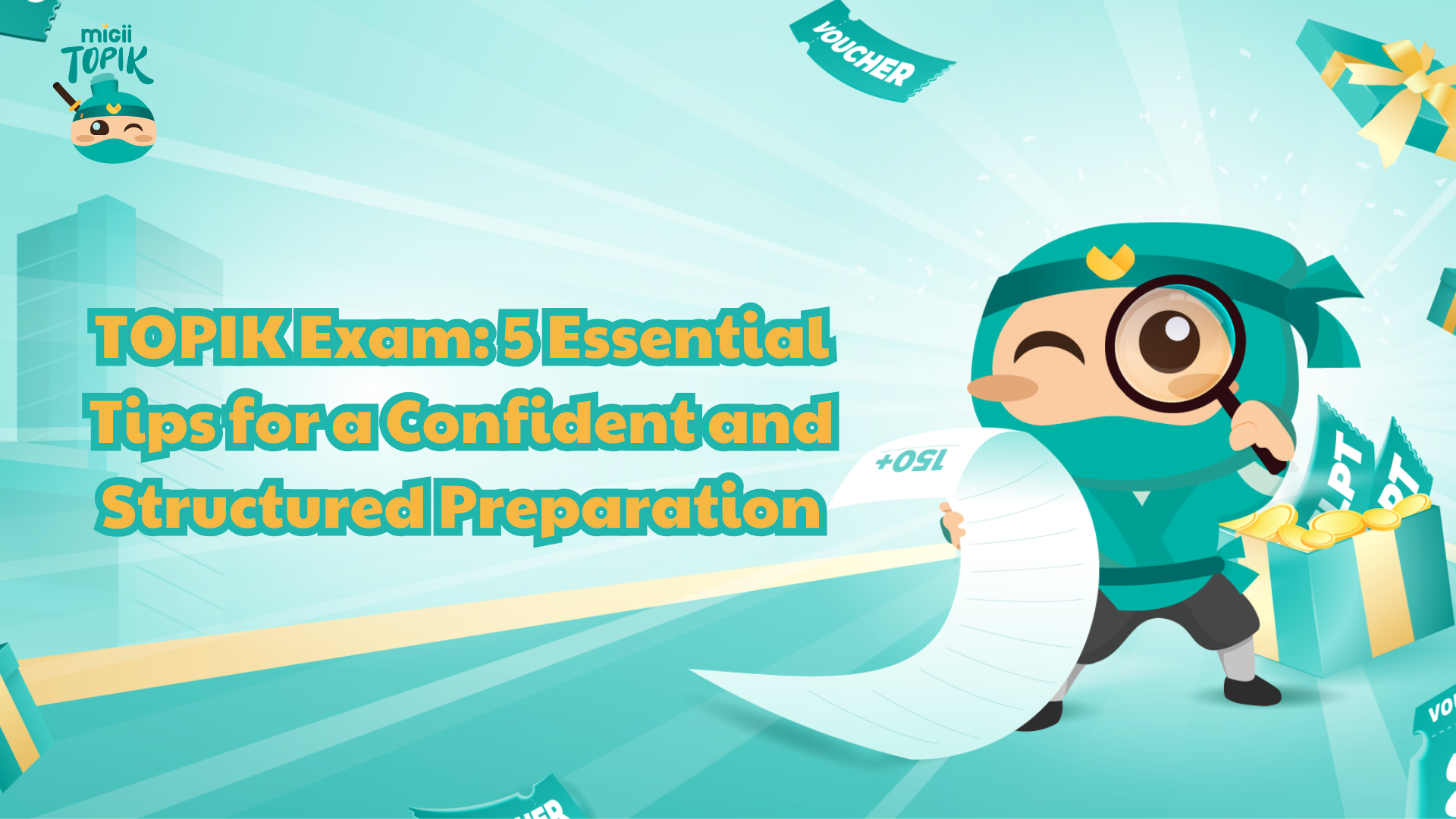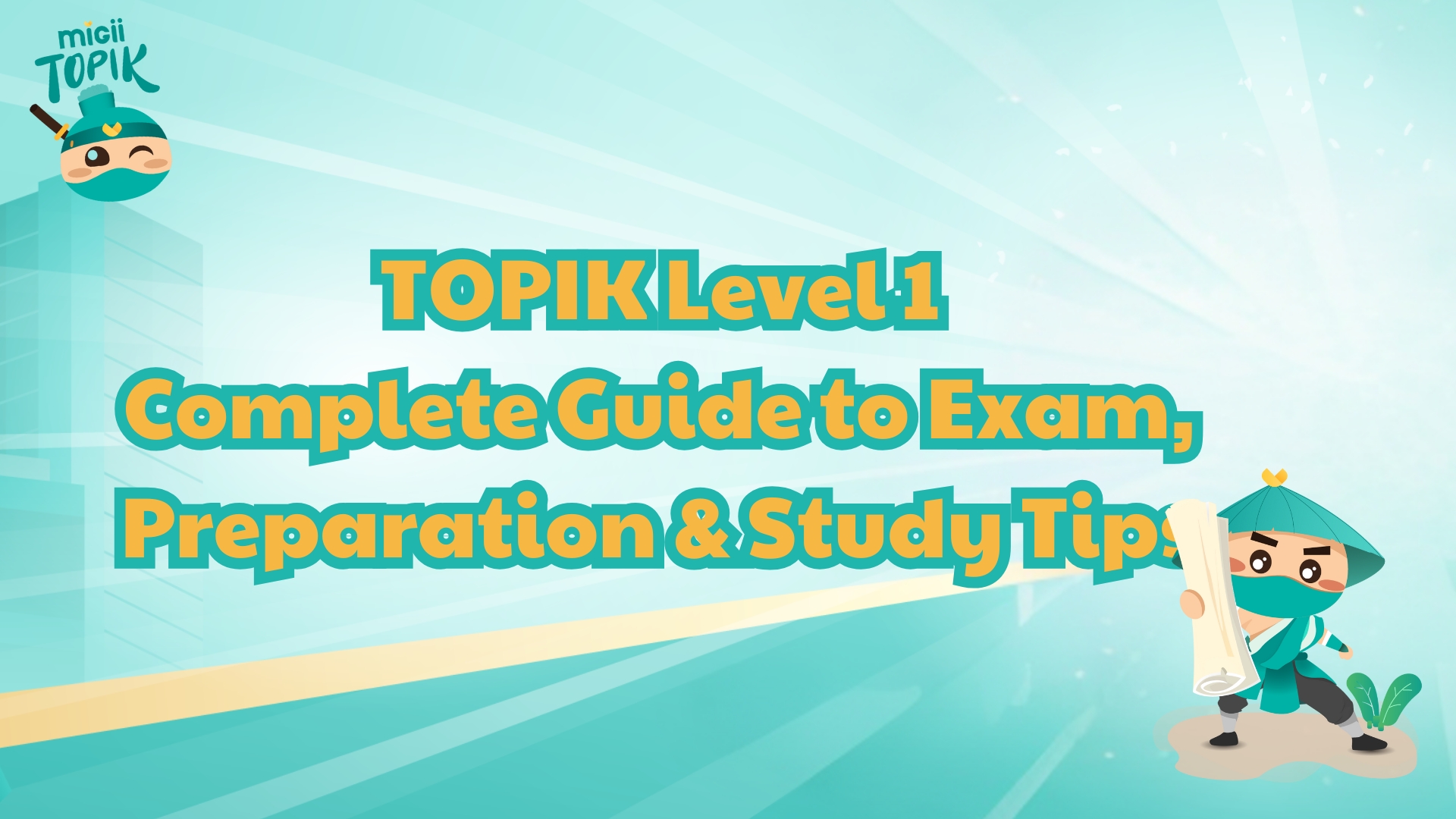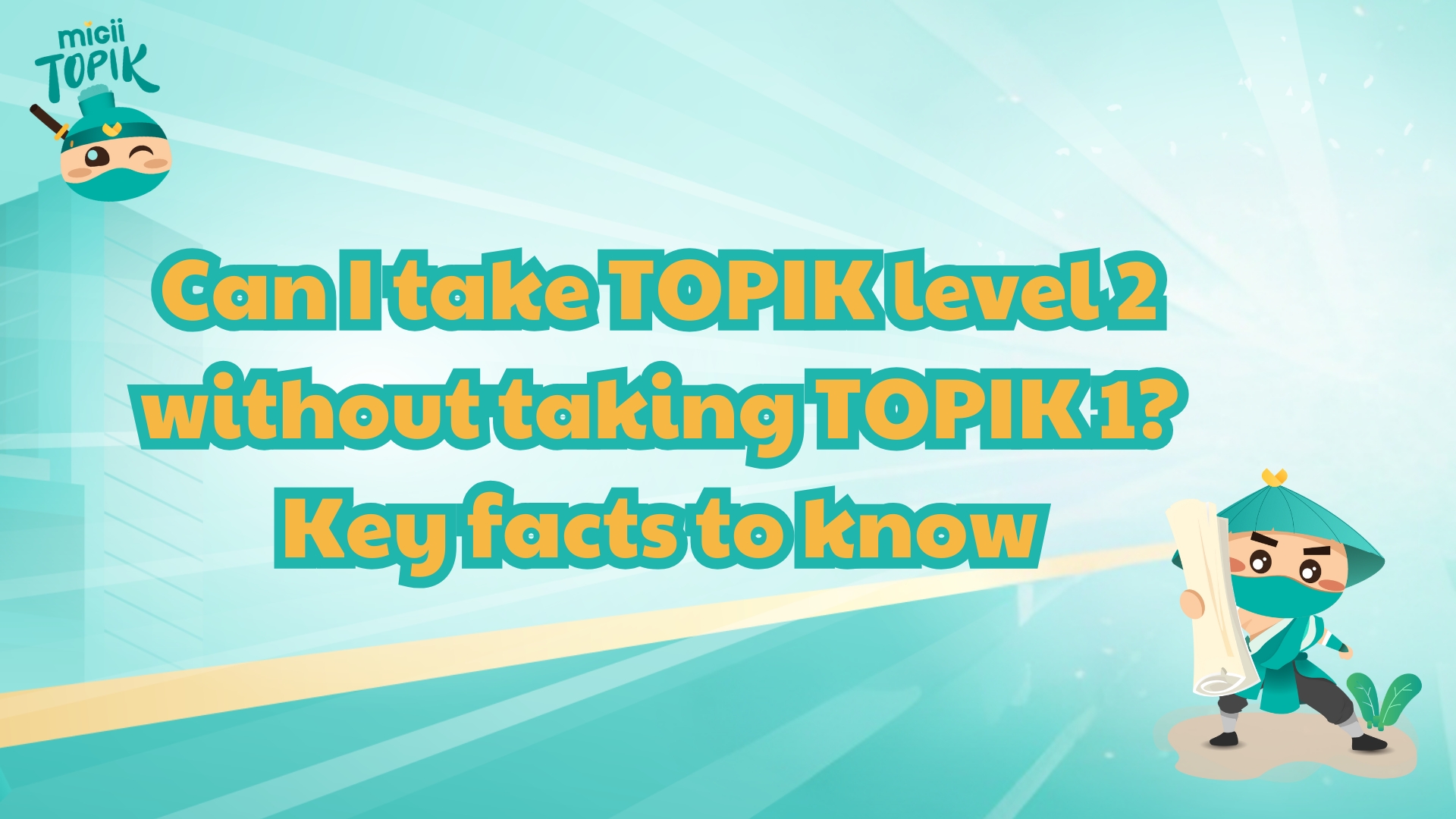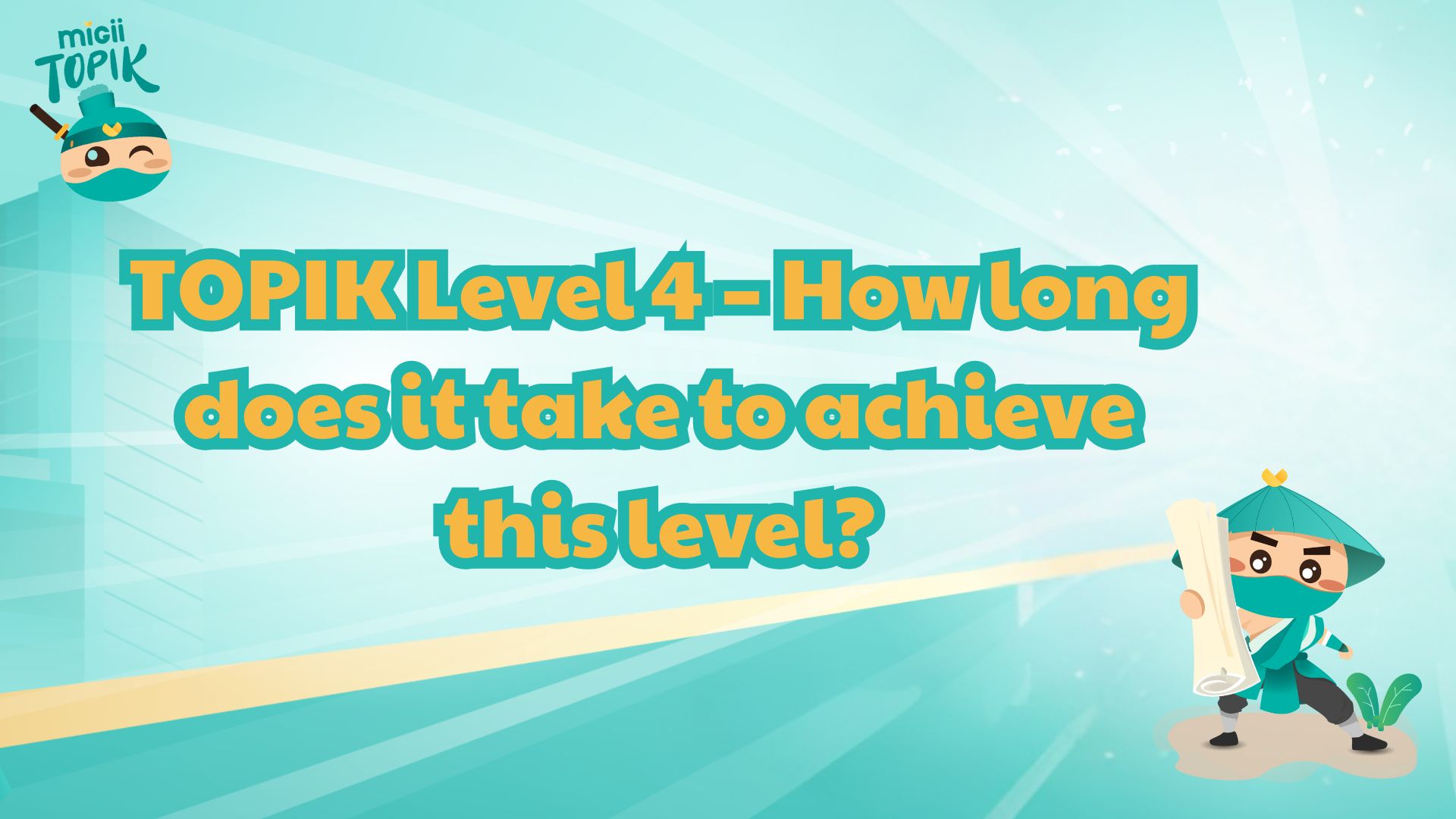Preparing for TOPIK Level 3 is a key milestone for anyone learning Korean, marking the transition from beginner to intermediate proficiency. If you’re wondering how to get TOPIK Level 3 or how to pass TOPIK Level 3 efficiently, this guide will walk you through the essential steps. This level helps you build confidence in everyday communication, reading, and writing simple texts with accuracy. Migii will guide you through understanding the test format, mastering key skills, and providing study tips and resources to help you achieve your TOPIK Level 3 goals successfully.
What is TOPIK level 3?
TOPIK Level 3 is the first stage of the intermediate level in the Korean language proficiency system, known as TOPIK II, which includes Levels 3–6. In other words, TOPIK 2 Level 3 marks the beginning of your journey into intermediate Korean proficiency (TOPIK 3 Korean). Reaching this level means you have moved beyond basic communication and can now handle more complex situations in daily life, school, or simple workplace settings using Korean.
Learners at this level are expected to understand conversations and written texts on familiar topics such as hobbies, travel, health, and culture. You should be able to follow short news reports, social media posts, or everyday announcements, as well as write short paragraphs expressing opinions or describing experiences logically.
In practical terms, TOPIK level 3 proves that you can:
- Maintain basic conversations in Korean without relying heavily on translation.
- Read and understand short essays, letters, or notices related to daily life.
- Write short texts such as diary entries, simple reports, or opinion paragraphs.
- Use a range of grammar and vocabulary suitable for general social communication.
Achieving this level is often considered the gateway to studying or working in Korea, as many universities, training programs, and companies accept TOPIK level 3 as proof of practical language ability. It’s also the foundation for progressing to higher levels like TOPIK level 4, where you can engage in more advanced academic or professional communication.
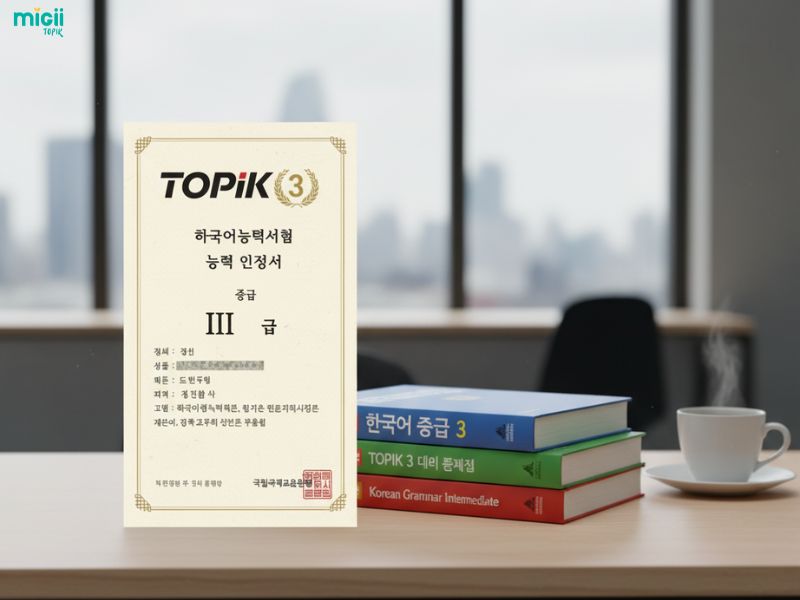
TOPIK Level 3 shows intermediate Korean skills for daily life, study, and work
How hard is TOPIK level 3?
TOPIK Level 3 (also referred to as TOPIK II Level 3) is considered a moderate challenge and represents your first real step into the intermediate stage of Korean learning. At this TOPIK 3 level, you start moving beyond memorizing simple sentences and begin applying Korean naturally in real-life situations. Compared with TOPIK Level 2, it requires stronger grammar skills, a broader vocabulary, and better reading comprehension. However, it remains easier than TOPIK Level 4, which focuses on academic and abstract topics.
To pass Level 3, you need a total score between 120 and 149 out of 300 on the TOPIK II exam. The test covers listening, reading, and writing sections, each scored from 0 to 100. Learners often find that listening and reading are manageable with regular exposure to Korean content, while writing tends to be the most difficult part because it demands logical structure and accurate grammar.
In general, learners who have completed beginner courses (Levels 1 and 2) usually need about 6 to 9 months of consistent study to reach Level 3. This may include:
Expanding vocabulary to around 2,000 – 2,500 words.
- Practicing intermediate grammar patterns that connect ideas smoothly.
- Reading short articles or dialogues daily to improve comprehension speed.
- Writing one short paragraph every few days to strengthen fluency and confidence.
Common challenges for TOPIK 3 candidates include:
- Struggling with long reading passages that contain unfamiliar vocabulary.
- Managing time effectively during the 3-hour test.
- Organizing ideas logically in the writing section.
While TOPIK Level 3 can be demanding at first, it is also one of the most rewarding milestones for learners. It marks the point where you can begin to use Korean independently, such as ordering food, expressing your thoughts, or understanding Korean media without needing constant translation. With consistent practice and a clear study plan, reaching Level 3 is completely achievable.
Structure of the TOPIK level 3 test
The TOPIK Level 3 test is part of the TOPIK II exam (TOPIK II Level 3), which covers Levels 3 to 6. It evaluates your ability to use Korean (TOPIK 3 Korean) in real-life, academic, and professional contexts. It is designed to evaluate your ability to use Korean in real-life, academic, and professional situations. The exam focuses on three key skills: listening, writing, and reading. There is currently no speaking section, although a separate TOPIK Speaking Test is being developed in Korea for future implementation.
Here is an overview of the test structure:
|
Section |
Number of Questions |
Time Limit |
Score Range |
Description |
|
Listening |
50 questions |
60 minutes |
0 – 100 |
Tests comprehension of everyday conversations, short news reports, and formal announcements. Audio is played once, using natural speed and standard pronunciation. |
|
Writing |
4 tasks (2 short + 2 long) |
50 minutes |
0 – 100 |
Evaluates your ability to complete sentences, write short paragraphs, and compose a short essay (around 200–300 words) using correct grammar and logical flow. |
|
Reading |
50 questions |
70 minutes |
0 – 100 |
Measures reading comprehension through ads, letters, blogs, and short essays that test vocabulary, main ideas, and inference skills. |
- Total duration: 180 minutes (3 hours)
- Maximum score: 300 points
The test is usually held six times a year in Korea and in several international locations, typically in April, May, July, October, and November. The results are announced about one month after the exam date.
To achieve TOPIK Level 3, candidates need a total score between 120 and 149 out of 300. Scoring 150 or higher qualifies you for TOPIK Level 4.
Test-taking tips:
- Manage your time carefully. Aim to spend no more than one minute per question in listening and reading.
- Use the first few minutes of the writing section to plan your ideas before you start writing.
- Review your answers in the last five to seven minutes of each section.
Understanding the structure and timing of each part of the test is crucial. Once you are familiar with the format, you can focus on practicing efficiently and building the confidence needed to perform well on exam day.
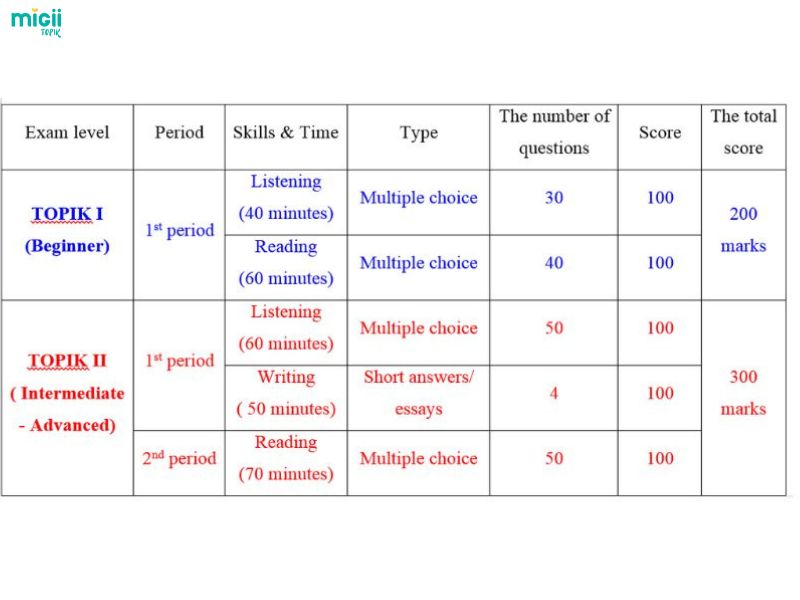
TOPIK Level 3 Test Structure
Key skills to pass TOPIK level 3
To pass TOPIK Level 3 successfully, you need to build balanced skills in grammar, vocabulary, reading, writing, and listening. At this level, learners should move beyond memorization and start using Korean naturally in real-life situations. Here are the key skills to focus on during your preparation.
Build a strong grammar foundation
Grammar plays a major role in all three sections of the exam. To reach Level 3, you should be comfortable with intermediate grammar patterns that help you connect ideas and express relationships such as cause, contrast, or condition.
Some of the most common grammar forms at this level include:
–(으)면, –지만, –으니까, –기 때문에, –게 되다, –(으)ㄴ 적이 있다, and –기로 하다.
These structures allow you to describe experiences, express reasons, or explain plans logically. For example:
- 한국에 간 적이 있어요. (I have been to Korea before.)
- 시간이 없기 때문에 숙제를 못 했어요. (I couldn’t do my homework because I didn’t have time.)
To master grammar effectively, study two or three patterns per week, create your own sentences using them, and review through short quizzes on platforms like Migii TOPIK.
Expand your vocabulary and reading comprehension
A solid vocabulary base is essential for understanding listening and reading questions. Learners at Level 3 should know about 2,000 to 2,500 words, focusing on topics such as family, school, work, health, and hobbies.
Try to study words by theme rather than by random lists. For example, when learning about travel, include related words like 공항 (airport), 짐 (luggage), 표 (ticket), and 여행하다 (to travel). Reading short Korean articles, news headlines, and social media posts can also help you learn how these words appear naturally in context.
When reading, focus on grasping the main idea instead of translating every word. Highlight key phrases and note new expressions to review later. For a complete list of useful TOPIK Level 3 vocabulary, check out this resource
Improve listening accuracy
Listening comprehension makes up a large portion of the TOPIK Level 3 score. You will hear conversations and short reports at a natural speaking pace, so consistent exposure to authentic Korean audio is essential.
To strengthen listening skills:
- Watch short Korean news clips or YouTube videos with Korean subtitles.
- Listen to podcasts such as Talk To Me In Korean or KBS Easy Korean News.
- Practice summarizing what you hear in one or two sentences.
- If possible, listen to the same audio several times, first to understand the general meaning and then to focus on details such as grammar or vocabulary.
For extra listening practice and downloadable audio materials, check out this resource
Practice writing short and clear paragraphs
Writing is often the most challenging section for Level 3 learners, as it requires not only correct grammar but also logical flow and organization. Typical tasks include completing sentences, describing experiences, or expressing opinions on everyday topics.
For example, you may be asked to write about “your favorite season” or “a memorable experience with a friend.” Aim to write around 200 to 300 characters per essay.
To practice effectively:
- Plan your paragraph with a clear beginning, middle, and end.
- Use linking words like 그래서 (so), 그러나 (however), and 그리고 (and).
- Check your work for grammar and spacing errors before moving on.
- Writing regularly, even short diary entries, will help you build confidence and improve fluency.
Strengthen test-taking strategies
Finally, practice under timed conditions to get used to the real exam environment. Take mock tests weekly to identify weak areas and track your progress. Learn to manage time efficiently by spending no more than one minute per question in listening and reading.
After each practice test, review your mistakes and note recurring grammar or vocabulary issues. This reflection process is key to improving your score.
Study plan to get TOPIK level 3
If you are wondering how to get TOPIK Level 3, consistency and structured study are key. Achieving this TOPIK 3 level requires steady effort, smart planning, and daily exposure to Korean. Most learners can reach this goal within six to nine months of regular study.
Below is a sample weekly study plan that balances grammar, vocabulary, reading, writing, and listening practice.
|
Day |
Focus area |
Study activity |
|
Monday |
Grammar |
Review 2 – 3 new grammar patterns. Write example sentences and test yourself using Migii TOPIK quizzes. |
|
Tuesday |
Listening |
Watch a short Korean video or listen to a 15-minute podcast. Summarize the main idea in Korean. |
|
Wednesday |
Reading |
Read a short article or blog post on Naver. Highlight new words and note unfamiliar grammar structures. |
|
Thursday |
Writing |
Write one short paragraph (150 – 200 characters) about a familiar topic like your weekend or hobbies. |
|
Friday |
Vocabulary |
Learn 30 – 40 new words by theme (e.g., school, travel, emotions). Review using flashcards or apps. |
|
Saturday |
Mock Test |
Take one section of a past TOPIK II test under timed conditions to build exam stamina. |
|
Sunday |
Review |
Go over your mistakes, rewrite your essay, and review difficult vocabulary or grammar points. |
Tips to Make the Study Plan More Effective
- Study a little every day: Short, consistent sessions (1 – 1.5 hours daily) are more effective than long, irregular ones.
- Combine multiple skills: When reading or listening, note down grammar patterns and new words to review later. This reinforces both comprehension and vocabulary retention.
- Set weekly goals: For example, aim to learn 150 new words, review 10 grammar points, or write 3 short essays per week.
- Track your progress: Use tools like Migii TOPIK to record your scores, monitor improvement, and identify weak areas that need extra attention.
- Simulate real test conditions: Take full mock exams once a month to get used to the three-hour format and to practice time management.
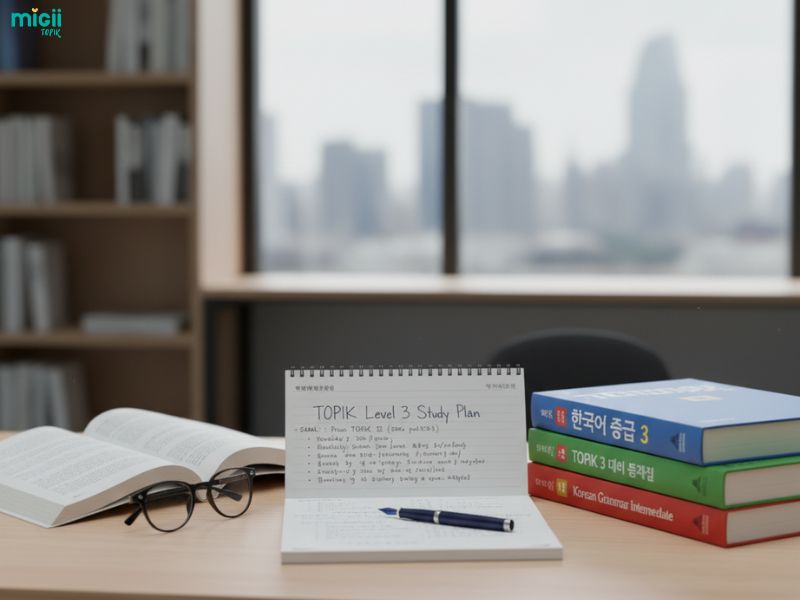
A structured weekly study plan to prepare effectively for TOPIK Level 3
Recommended Resources and Practice Tests
Choosing the right study materials is key to preparing effectively for TOPIK Level 3. Below are some trusted resources, books, and online tools to help you practice efficiently and build confidence before exam day.
Official TOPIK past papers
Practicing with official past exams is one of the most effective ways to understand the structure, timing, and question types of the TOPIK Level 3 test. By reviewing real papers, you can identify common patterns, measure your progress, and become more confident before the actual exam.
Among the available resources, Migii TOPIK stands out as an all-in-one online platform that provides interactive past papers with automatic scoring, detailed explanations, and section-by-section performance tracking. It helps learners simulate real exam conditions and pinpoint areas that need improvement.
You can download or access TOPIK Level 3 practice tests here (insert your link). Make sure to take each test under timed conditions, record your scores, and review incorrect answers carefully to strengthen your weak points before test day.
You can explore and download official TOPIK Level 3 past papers from this source:
Download TOPIK II Practice Tests (Intermediate Level 3 – 4):
Best books for TOPIK level 3 preparation
Books are an excellent way to learn systematically and deepen your understanding of grammar, vocabulary, and writing. Some recommended books for this level include:
- TOPIK Master Intermediate (TOPIK II): A comprehensive book that covers grammar, reading, listening, and writing with step-by-step explanations and practice tests.
- Cracking the TOPIK II Writing (by Won Eunyeoung & Lee Yumi): A specialized book for mastering the TOPIK II writing section. It provides detailed guidance for questions 51–54, including paragraph organization, grammar usage, and essay structure. Learners can practice with real examples and model answers to improve sentence flow and logical expression.
- Complete Guide to TOPIK II: Offers realistic mock tests with detailed explanations of answers, time management tips, and vocabulary lists for intermediate learners.
When using textbooks, it’s best to study one skill at a time and complement book exercises with online practice to build both accuracy and speed.
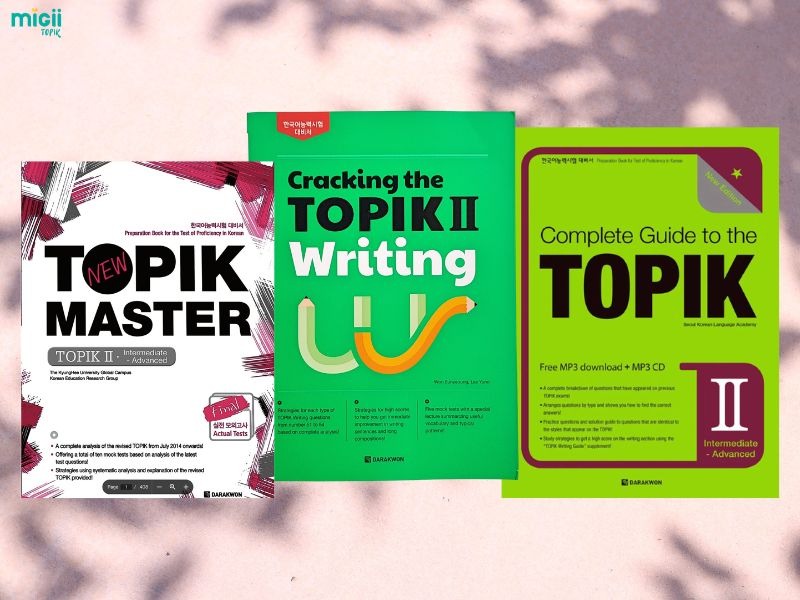
Recommended books to master grammar, writing, and test skills for TOPIK Level 3
Online learning tools and apps
Digital platforms can make your preparation more flexible and engaging. They allow you to practice anytime, anywhere, and track your progress automatically.
- Migii TOPIK: A comprehensive online learning platform designed specifically for TOPIK preparation. It provides grammar lessons, vocabulary flashcards, mock tests with auto-grading, and progress tracking. The app also highlights weak areas and suggests targeted practice exercises.
- Naver Dictionary: Useful for checking definitions, example sentences, and idiomatic expressions while reading or writing.
- Talk To Me In Korean: Great for improving listening comprehension and pronunciation through natural Korean conversations and lessons.
- YouTube Channels (e.g., KoreanClass101, Seemile Korean): Ideal for listening and reading practice, especially for learners who prefer visual and audio content.
Sample practice tests
Here are some downloadable and online resources where you can take full-length mock tests:
- Migii TOPIK Practice Tests: Interactive tests with real exam timing, automatic scoring, and detailed explanations.
- TOPIK Guide Practice Papers: PDF-based tests that simulate the actual exam format.
- Hot TOPIK II Actual Test Book Series: A printed collection of past papers with answer keys and translations for self-study.
Tips to pass TOPIK level 3 faster
Achieving TOPIK Level 3 faster requires a smart and consistent study approach that focuses on efficiency rather than intensity. Instead of spending long hours studying without structure, it’s better to build steady habits, practice actively, and use effective tools. Below are key tips to help you reach your goal more quickly:
- Set clear goals: Decide when you want to take the exam and what score you aim for. Break your goal into smaller weekly targets, such as learning 100 new words, reviewing 5 grammar points, or completing one mock test.
- Study regularly: Dedicate at least 1 – 2 hours per day to Korean. Keep a balanced routine between grammar, vocabulary, listening, reading, and writing.
- Immerse yourself in Korean: Watch K-dramas or YouTube videos with Korean subtitles, listen to podcasts like Talk To Me In Korean, and read short articles daily to build natural understanding.
- Focus on writing practice: The writing section is often the hardest, so write short paragraphs every week about familiar topics such as hobbies or daily life. Check your writing with examples or feedback from Migii TOPIK to improve grammar and structure.
- Review your mistakes carefully: After every test or exercise, analyze the errors you made. Keep a correction notebook for grammar and vocabulary mistakes, and revisit it weekly to reinforce learning.
- Take mock tests often: Simulate real exam conditions at least once every two weeks. Review your performance and adjust your study focus accordingly. Use Migii TOPIK for timed mock tests, auto-scoring, and explanations.
- Manage your time during the exam: Spend about one minute per question in listening and reading, and reserve five to seven minutes at the end for review. Plan your ideas before writing to make your essay clear and logical.
- Stay motivated: Reward yourself for small achievements, study with friends or online groups, and remind yourself of your learning purpose to stay consistent.
Final thoughts
Reaching TOPIK Level 3 is a meaningful milestone that shows your ability to communicate naturally, read everyday materials, and express ideas clearly in Korean. With consistent effort, smart strategies, and regular exposure to the language, this goal is completely achievable and often faster than expected. To make your preparation more effective, start practicing with Migii TOPIK, an all-in-one learning platform that provides mock tests, grammar lessons, and personalized progress tracking. Study smarter, stay motivated, and let Migii help you achieve success in your next TOPIK Level 3 exam.

